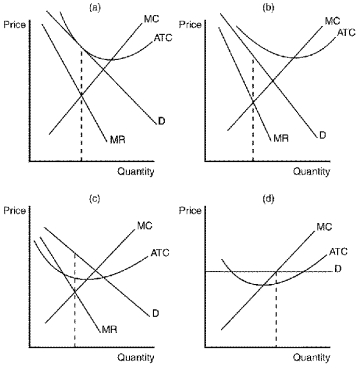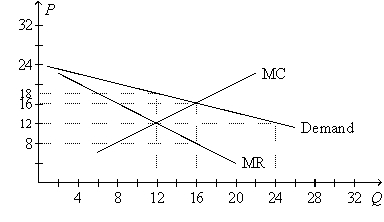Correct Answer

verified
Correct Answer
verified
True/False
When McDonald's opens a store in Dhaka,Bangladesh,it has a strong incentive to enforce product quality consistent with stores in the United States.
Correct Answer

verified
Correct Answer
verified
Multiple Choice
Figure 16-4  -Refer to Figure 16-4.Which of the graphs depicts a short-run equilibrium that will encourage the entry of other firms into a monopolistically competitive industry?
-Refer to Figure 16-4.Which of the graphs depicts a short-run equilibrium that will encourage the entry of other firms into a monopolistically competitive industry?
A) panel a
B) panel b
C) panel c
D) panel d
Correct Answer

verified
Correct Answer
verified
Multiple Choice
A downward-sloping demand curve
A) is a feature of all monopolistically competitive firms.
B) means that the firm in question will never experience a zero profit.
C) causes marginal revenue to exceed price.
D) prohibits firms from earning positive economic profits in the long run.
Correct Answer

verified
Correct Answer
verified
Multiple Choice
Table 16-5
Traci's Hairstyling is one salon among many in the market for hairstyling.The following table presents cost and revenue data for hair cuts at Traci's Hairstyling.
 -Refer to Table 16-5.At the profit-maximizing quantity,what is Traci's total profit?
-Refer to Table 16-5.At the profit-maximizing quantity,what is Traci's total profit?
A) $30
B) $59
C) $77
D) $84
Correct Answer

verified
Correct Answer
verified
Multiple Choice
If firms in a monopolistically competitive market are earning economic profits,which of the following scenarios would best describe the change existing firms would face as the market adjusts to the long-run equilibrium?
A) an increase in demand for each firm
B) a decrease in demand for each firm
C) a downward shift in the marginal cost curve for each firm
D) an upward shift in the marginal cost curve for each firm
Correct Answer

verified
Correct Answer
verified
Multiple Choice
Table 16-2
The following table shows the total output produced by the top six firms as well as the total industry output for each industry.
 -Refer to Table 16-2.Which industry has the highest concentration ratio?
-Refer to Table 16-2.Which industry has the highest concentration ratio?
A) Industry A
B) Industry B
C) Industry C
D) Industry D
Correct Answer

verified
Correct Answer
verified
Multiple Choice
The commercial jetliner industry consisting of Boeing and Airbus would best be described as a (an)
A) perfectly competitive market.
B) monopolistically competitive market.
C) oligopoly.
D) monopoly.
Correct Answer

verified
Correct Answer
verified
Multiple Choice
Two soft drinks sit side-by-side in a grocery store: A six-pack of Coca-Cola (a brand name) sells for $3.00,while a six-pack of Uncle Don's cola (not a brand name) sells for $1.50.Even defenders of brand names would have to admit that
A) no rational consumer would spend twice as much for Coca-Cola as he would for Uncle Don's cola.
B) the side-by-side presence of these two colas conveys no useful information to consumers.
C) Coca-Cola has no incentive to maintain the quality of its product just because of the Coca-Cola brand name.
D) None of the above is correct.
Correct Answer

verified
Correct Answer
verified
Multiple Choice
A market structure with only a few sellers,each offering similar or identical products,is known as
A) oligopoly.
B) monopoly.
C) monopolistic competition.
D) perfect competition.
Correct Answer

verified
Correct Answer
verified
Multiple Choice
A monopolistically competitive market is like both a competitive market and a monopoly in that firms in all three market structures
A) can earn economic profits in the short run.
B) can earn economic profits in the long run.
C) charge a price above marginal cost.
D) All of the above are correct.
Correct Answer

verified
Correct Answer
verified
Multiple Choice
Television advertisements aired during major sporting events are very expensive.A theory asserting that people buy a product simply because it is advertised would suggest that information on the high cost of advertising
A) enhances the effectiveness of the advertisement.
B) reduces people's willingness to purchase advertised products.
C) is leaked to discredit the firms that spend so much on advertising.
D) reduces the effective staying power of a product.
Correct Answer

verified
Correct Answer
verified
Multiple Choice
Which of the following statements is correct?
A) Firms in monopolistic competition and monopoly can earn economic profits in both the short run and the long run.
B) Both perfectly competitive and monopolistically competitive firms charge a price equal to marginal cost.
C) Firms in perfect competition,monopolistic competition,and monopoly maximize profits by producing where marginal revenue equals marginal cost.
D) Both perfectly competitive and monopolistically competitive firms produce the welfare-maximizing level of output.
Correct Answer

verified
Correct Answer
verified
Multiple Choice
For a profit-maximizing monopolistically competitive firm,price exceeds marginal cost in
A) the short run but not in the long run.
B) the long run but not in the short run.
C) both the short run and the long run.
D) neither the short run nor the long run.
Correct Answer

verified
Correct Answer
verified
Multiple Choice
In a long-run equilibrium,a firm in a monopolistically competitive market operates
A) where marginal revenue is zero.
B) where marginal revenue is negative.
C) on the rising portion of its average total cost curve.
D) on the declining portion of its average total cost curve.
Correct Answer

verified
Correct Answer
verified
Multiple Choice
The entry of new firms into a monopolistically competitive market is accompanied by
A) both positive and negative externalities.
B) only positive externalities.
C) only negative externalities.
D) only private profit opportunities (no externalities) .
Correct Answer

verified
Correct Answer
verified
Multiple Choice
Which of the following conditions is characteristic of a monopolistically competitive firm in short-run equilibrium?
A) P > ATC
B) P = ATC
C) P < ATC
D) Any of the above could be correct.
Correct Answer

verified
Correct Answer
verified
Multiple Choice
Which of the following conditions is characteristic of a monopolistically competitive firm in long-run equilibrium?
A) P > MR and P = MC
B) ATC = demand and MR = MC
C) P < MC and demand = ATC
D) P > ATC and demand > MR
Correct Answer

verified
Correct Answer
verified
Multiple Choice
In a monopolistically competitive market,
A) the entry of new firms creates externalities.
B) the absence of restrictions on entry by new firms ensures that there will be no deadweight loss.
C) there are always too many firms in the market relative to the socially-optimal number of firms.
D) firms cannot earn positive economic profits in the short run.
Correct Answer

verified
Correct Answer
verified
Multiple Choice
Figure 16-1.The figure is drawn for a monopolistically competitive firm.  -Refer to Figure 16-1.Suppose that average total cost is $18 when Q=12.What is the profit-maximizing price and resulting profit?
-Refer to Figure 16-1.Suppose that average total cost is $18 when Q=12.What is the profit-maximizing price and resulting profit?
A) P=$12,profit=$0
B) P=$18,profit=$72
C) P=$18,profit=$24
D) P=$18,profit=$0
Correct Answer

verified
Correct Answer
verified
Showing 321 - 340 of 416
Related Exams